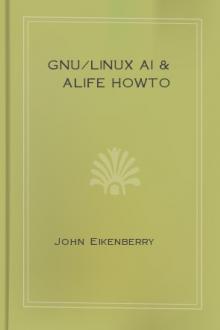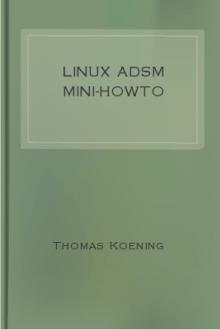GNU/Linux AI & Alife HOWTO by John Eikenberry (easy books to read in english .txt) 📖

- Author: John Eikenberry
- Performer: -
Book online «GNU/Linux AI & Alife HOWTO by John Eikenberry (easy books to read in english .txt) 📖». Author John Eikenberry
download. :P
Aglets Workbench
� Web site: www.trl.ibm.com/aglets/index_e.htm
An aglet is a Java object that can move from one host on the
Internet to another. That is, an aglet that executes on one
host can suddenly halt execution, dispatch to a remote host, and
resume execution there. When the aglet moves, it takes along its
program code as well as its state (data). A builtin security
mechanism makes it safe for a computer to host untrusted aglets.
The Java Aglet API (J-AAPI) is a proposed public standard for
interfacing aglets and their environment. J-AAPI contains
methods for initializing an aglet, message handling, and
dispatching, retracting, deactivating/activating, cloning, and
disposing of the aglet. J-AAPI is simple, flexible, and stable.
Application developers can write platform-independent aglets and
expect them to run on any host that supports J-AAPI.
AJA
� Web site: home.arcor.de/michal.badonsky/AJA/
AJA (Adaptable Java Agents) consists of two programming
languages. HADL (Higher Agent Definition Language) is a higher-level language used for the description of the main agent parts.
Java+ is the lower-level language used for the programming of
the agent parts defined in HADL. It is actually Java enriched
with the constructs for accessing higher-level agent parts
defined in HADL.
A.L.I.C.E.
� Web site: www.alicebot.org
The ALICE software implements AIML (Artificial Intelligence
Markup Language), a non-standard evolving markup language for
creating chat robots. The primary design feature of AIML is
minimalism. Compared with other chat robot languages, AIML is
perhaps the simplest. The pattern matching language is very
simple, for example permitting only one wild-card (‘*’) match
character per pattern. AIML is an XML language, implying that it
obeys certain grammatical meta-rules. The choice of XML syntax
permits integration with other tools such as XML editors.
Another motivation for XML is its familiar look and feel,
especially to people with HTML experience.
Ara
� Web site: wwwagss.informatik.uni—
kl.de/Projekte/Ara/index_e.html
Ara is a platform for the portable and secure execution of
mobile agents in heterogeneous networks. Mobile agents in this
sense are programs with the ability to change their host machine
during execution while preserving their internal state. This
enables them to handle interactions locally which otherwise had
to be performed remotely. Ara’s specific aim in comparison to
similar platforms is to provide full mobile agent functionality
while retaining as much as possible of established programming
models and languages.
BattleBots
� Web site: www.bluefire.nu/battlebots/
AI programming game where you design the bot by selecting
hardware and programming its CPU, then competing with other
bots. Competitions can have teams and special rules for a game.
The hardware for use in your bot includes weapons, engine,
scanners, CPU, etc. The programming lauguage is dependent on the
CPU type and is similar to an assembly language.
Beegent
� Web site: www2.toshiba.co.jp/beegent/index.htm
Beegent is a new type of development framework in that it is a
100% pure agent system. As opposed to other systems which make
only some use of agents, Beegent completely “Agentifies” the
communication that takes place between software applications.
The applications become agents, and all messages are carried by
agents. Thus, Beegent allows developers to build flexible open
distributed systems that make optimal use of existing
applications.
Bond
� Web site: bond.cs.ucf.edu
Yet another java agent system…
Bond is a Java based distributed object system and agent
framework. It implements a message based middleware and
associated services like directory, persistence, monitoring and
security. Bond allows to easily build multi agent, distributed
applications. Another application of Bond will be a Virtual
Laboratory supporting data annotation and metacomputing.
Cadaver
� Web site: www.erikyyy.de/cadaver/
Cadaver is a simulated world of cyborgs and nature in realtime.
The battlefield consists of forests, grain, water, grass,
carcass (of course) and lots of other things. The game server
manages the game and the rules. You start a server and connect
some clients. The clients communicate with the server using a
very primitive protocol. They can order cyborgs to harvest
grain, attack enemies or cut forest. The game is not intended
to be played by humans! There is too much to control. Only for
die-hards: Just telnet to the server and you can enter commands
by hand. Instead the idea is that you write artificial
intelligence clients to beat the other artificial intelligences.
You can choose a language (and operating system) of your choice
to do that task. It is enough to write a program that
communicates on standard input and standard output channels.
Then you can use programs like “socket” to connect your clients
to the server. It is NOT needed to write TCP/IP code, although
i did so :) The battle shall not be boring, and so there is the
so called spyboss client that displays the action graphically on
screen.
Cougaar
� Web site: www.cougaar.org/
Cougaar is java-based architecture for the construction of
large-scale distributed agent-based applications. It is the
product of a multi-year DARPA research project into large scale
agent systems and includes not only the core architecture but
also a variety of demonstration, visualization and management
components to simplify the development of complex, distributed
applications. [Yet another java based agent system — ed.]
D’Agent (was AGENT TCL)
� Web site: agent.cs.dartmouth.edu/software/agent2.0/
� FTP site: ftp.cs.dartmouth.edu/pub/agents/
A transportable agent is a program that can migrate from machine
to machine in a heterogeneous network. The program chooses when
and where to migrate. It can suspend its execution at an
arbitrary point, transport to another machine and resume
execution on the new machine. For example, an agent carrying a
mail message migrates first to a router and then to the
recipient’s mailbox. The agent can perform arbitrarily complex
processing at each machine in order to ensure that the message
reaches the intended recipient.
DIET Agents
� Web site: diet-agents.sourceforge.net
DIET Agents is a lightweight, scalable and robust multiagent
platform in Java. It is especially suitable for rapidly
developing P2P prototype applications and/or adaptive,
distributed applications that use bottom-up, nature-inspired
techniques.
FIPA-OS
� Web site: fipa-os.sourceforge.net
� Secondary Web site:
www.nortelnetworks.com/products/announcements/fipa/
FIPA-OS is an open source implementation of the mandatory
elements contained within the FIPA specification for agent
interoperability. In addition to supporting the FIPA
interoperability concepts, FIPA-OS also provides a component
based architecture to enable the development of domain specific
agents which can utilise the services of the FIPA Platform
agents. It is implemented in Java.
FishMarket
� Web site: www.iiia.csic.es/Projects/fishmarket/
FM - The FishMarket project conducted at the Artificial
Intelligence Research Institute (IIIA-CSIC) attempts to
contribute in that direction by developing FM, an agent-mediated
electronic auction house which has been evolved into a test-bed
for electronic auction markets. The framework, conceived and
implemented as an extension of FM96.5 (a Java-based version of
the Fishmarket auction house), allows to define trading
scenarios based on fish market auctions (Dutch auctions). FM
provides the framework wherein agent designers can perform
controlled experimentation in such a way that a multitude of
experimental market scenarios—that we regard as tournament
scenarios due to the competitive nature of the domain— of
varying degrees of realism and complexity can be specified,
activated, and recorded; and trading (buyer and seller)
heterogeneous (human and software) agents compared, tuned and
evaluated.
GNU Robots
� Web site: www.gnu.org/software/robots/robots.html
GNU Robots is a game/diversion where you construct a program for
a little robot, then watch him explore a world. The world is
filled with baddies that can hurt you, objects that you can bump
into, and food that you can eat. The goal of the game is to
collect as many prizes as possible before are killed by a baddie
or you run out of energy. Robots can be written in Guile scheme
or using a GUI.
Grasshopper
� Web site: www.grasshopper.de/
Another Java agent system. Full featured and actively developed.
Commercial, but free. Historically targeted at embedded systems.
Hive
� Web site: hive.sourceforge.net
Hive is a Java software platform for creating distributed
applications. Using Hive, programmers can easily create systems
that connect and use data from all over the Internet. At its
heart, Hive is an environment for distributed agents to live,
communicating and moving to fulfill applications. We are trying
to make the Internet alive.
ICM
� Web site (bad link?): www.nar.fujitsulabs.com/
� SourceForge site: sourceforge.net/projects/networkagent/
The InterAgent Communication Model (ICM) is a communication
mechanism that can be used for sending messages between agents
in an asynchronous fashion. Its intended application area is as
a transportation mechanism for agent communication languages
(ACLs), such as KQML and FIPA’s ACL.
Jacomma
� Web site: jacomma.sourceforge.net
� SourceForge site: sourceforge.net/projects/jacomma/
Jacomma is an agent development platform/framework for
developing distributed, mobile, and reactive information agents
with heterogeneous communication capabilities, in Java and
JPython.
Jacomma provides a development framework and an execution
environment, which sits on top of the InterAgent Communication
Model infrastructure. The ICM defines a communication protocol,
a store and forward messaging architecture, and low level
communication infrastructure for message exchange.
Communication is truly asynchronous, based on TCP sockets.
ICM has an entry in this howto, or you can find it via a link
off the site.
Jade
� Web site: sharon.cselt.it/projects/jade/
JADE (Java Agent DEvelopment Framework) is a software framework
fully implemented in Java language. It simplifies the
implementation of multiagent systems through a middleware that
claims to comply with the FIPA specifications and through a set
of tools that supports the debugging and deployment phase. The
agent platform can be distributed across machines (which not
even need to share the same OS) and the configuration can be
controlled via a remote GUI. The configuration can be even
changed at runtime by moving agents from one machine to another
one, as and when required.
JAM Agent
� Web site: www.marcush.net/IRS/irs_downloads.html
JAM supports both top-down, goal-based reasoning and bottom-up
data-driven reasoning. JAM selects goals and plans based on
maximal priority if metalevel reasoning is not used, or user-developed metalevel reasoning plans if they exist. JAM’s
conceptualization of goals and goal achievement is more
classically defined (UMPRS is more behavioral performance-based
than truly goal-based) and makes the distinction between plans
to achieve goals and plans that simply encode behaviors. Goal-types implemented include achievement (attain a specified world
state), maintenance (re-attain a specified world state), and
performance. Execution of multiple simultaneous goals are
supported, with suspension and resumption capabilities for each
goal (i.e., intention) thread. JAM plans have explicit
precondition and runtime attributes that restrict their
applicability, a postcondition attribute, and a plan attributes
section for specifying plan/domain-specific plan features.
Available plan constructs include: sequencing, iteration,
subgoaling, atomic (i.e., non-interruptable) plan segments, n-branch deterministic and nondeterministic conditional
execution, parallel execution of multiple plan segments, goal-based or world state-based synchronization, an explicit failure-handling section, and Java primitive function definition through
building it into JAM as well as the invocation of predefined
(i.e., legacy) class members via Java’s reflection capabilities
without having to build it into JAM.
JASA
� Web site: www.csc.liv.ac.uk/~sphelps/jasa
� Alt Web site: sourceforge.net/projects/jasa/
JASA is a high performance auction simulator suitable for
conducting experiments in agent-based computational economics.
It implements various auction mechanisms, trading strategies and
experiments described in the computational economics literature,
and as the software matures we hope that it will become a
repository for reference implementations of commonly used
mechanisms, strategies and learning algorithms.
Jason
� Web site: jason.sourceforge.net
A Java-based interpreter for an extended version of AgentSpeak.
Unlike other BDI (Beliefs-Desires-Intentions) agent tools, Jason
implements the operational semantics of AgentSpeak, a BDI logic
programming language extensively discussed in the literature. It
is available as Open Source under GNU LGPL.
JATLite
� Web site: java.stanford.edu/
JATLite is providing a set of java





Comments (0)